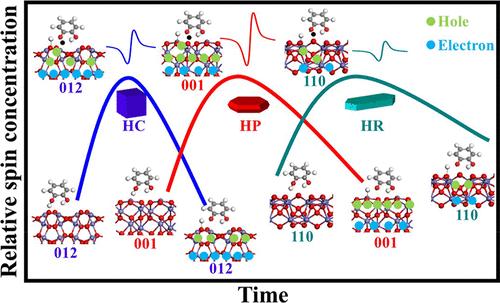赤铁矿上光生孔洞在自由基形成过程中被忽视的作用
IF 11.3
1区 环境科学与生态学
Q1 ENGINEERING, ENVIRONMENTAL
引用次数: 0
摘要
持久性自由基(PFRs)因其寿命长、反应活性高而受到广泛关注。然而,光生载流子在PFR形成中的作用仍未得到充分研究。结合实验和理论研究,对赤铁矿- sio2负载儿茶酚的PFR形成进行了比较和分析。仅在紫外光照射下观察到显著的PFRs。赤铁矿纳米板(HP, 1.29 × 1017自旋/mg)上的PFR浓度高于赤铁矿纳米立方(HC, 9.19 × 1016自旋/mg)和纳米棒(HR, 7.02 × 1016自旋/mg)上的PFR浓度。PFRs在HR (183 h t1/e)上的稳定性高于HP (95.4 h t1/e)和HC (37.7 h t1/e)。光电化学分析和猝灭实验表明,控制PFR形成的是光产生的空穴而不是电子。光生空穴通过控制儿茶酚p轨道上自旋和自旋电子的不对称分布来调节PFR的形成。孔洞数量和暴露面对PFRs的浓度和稳定性有显著影响。HP上PFRs浓度高是由于孔多,HC上PFRs稳定性弱是由于暴露的{012}关节面。本研究提出了一种由光生孔调控PFR形成的新机制,有助于更好地了解它们的环境功能和相关风险。本文章由计算机程序翻译,如有差异,请以英文原文为准。

Overlooked Role of Photogenerated Holes in Persistent Free Radical Formation on Hematite
Persistent free radicals (PFRs) have garnered considerable attention due to their long lifetime and high reactivity. However, the roles of photogenerated carriers in PFR formation remain underexplored. We compared and analyzed the PFR formation on hematite-SiO2 loaded catechol, combining experimental and theoretical investigations. Significant PFRs were observed only under ultraviolet light irradiation. The PFR concentration on hematite nanoplates (HP, 1.29 × 1017 spins/mg) was higher than those on hematite nanocubes (HC, 9.19 × 1016 spins/mg) and nanorods (HR, 7.02 × 1016 spins/mg). A stronger stability of PFRs on HR (183 h of t1/e) was observed compared with HP (95.4 h of t1/e) and HC (37.7 h of t1/e). Photoelectrochemical analysis and quenching experiments indicated that photogenerated holes, rather than electrons, controlled the PFR formation. Photogenerated holes manipulate the asymmetric distribution of up-spin and down-spin electrons in the p orbital of catechol to regulate PFR formation. Hole quantity and exposed facets caused significant differences in the concentration and stability of PFRs. The high concentration of PFRs on HP is due to abundant holes, while the weak stability of PFRs on HC is due to the exposed {012} facet. This study introduces a novel mechanism for PFR formation regulated by photogenerated holes, contributing to a better understanding of their environmental function and associated risks.
求助全文
通过发布文献求助,成功后即可免费获取论文全文。
去求助
来源期刊

环境科学与技术
环境科学-工程:环境
CiteScore
17.50
自引率
9.60%
发文量
12359
审稿时长
2.8 months
期刊介绍:
Environmental Science & Technology (ES&T) is a co-sponsored academic and technical magazine by the Hubei Provincial Environmental Protection Bureau and the Hubei Provincial Academy of Environmental Sciences.
Environmental Science & Technology (ES&T) holds the status of Chinese core journals, scientific papers source journals of China, Chinese Science Citation Database source journals, and Chinese Academic Journal Comprehensive Evaluation Database source journals. This publication focuses on the academic field of environmental protection, featuring articles related to environmental protection and technical advancements.
 求助内容:
求助内容: 应助结果提醒方式:
应助结果提醒方式:


